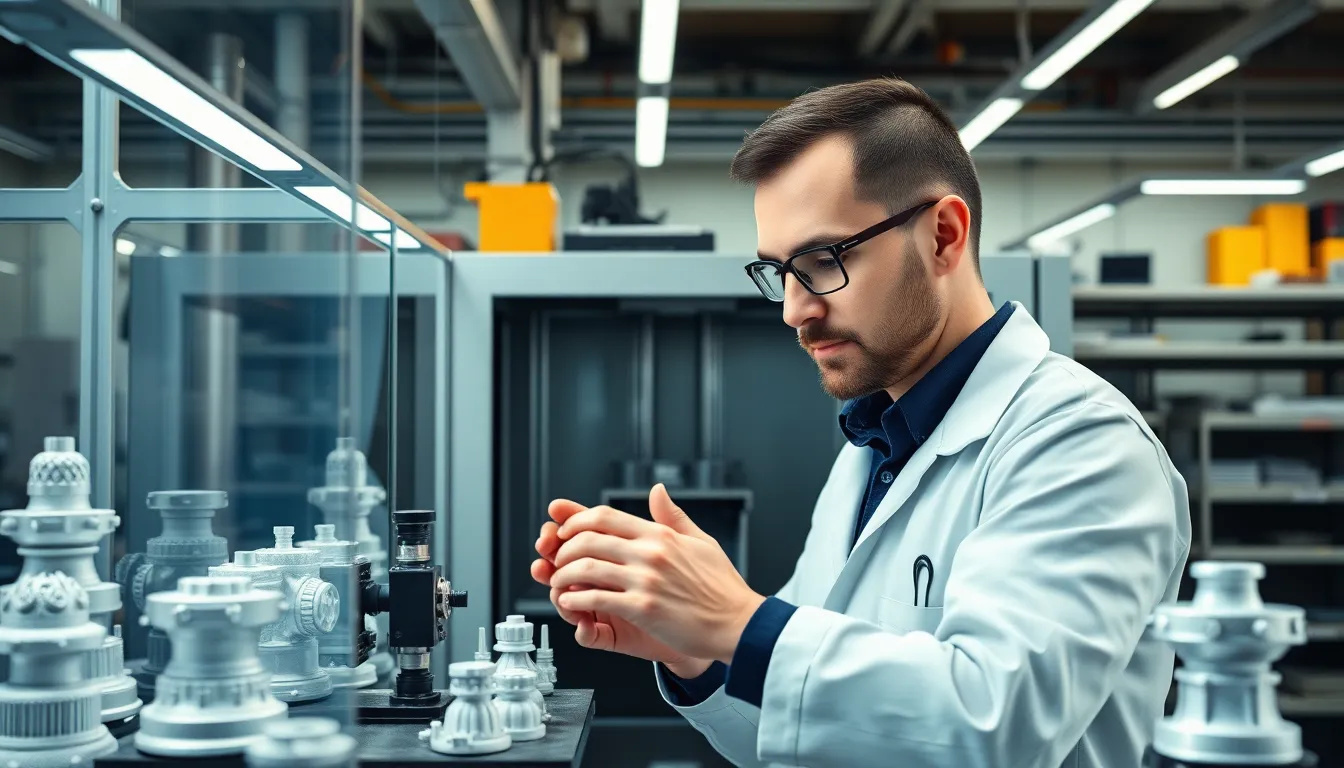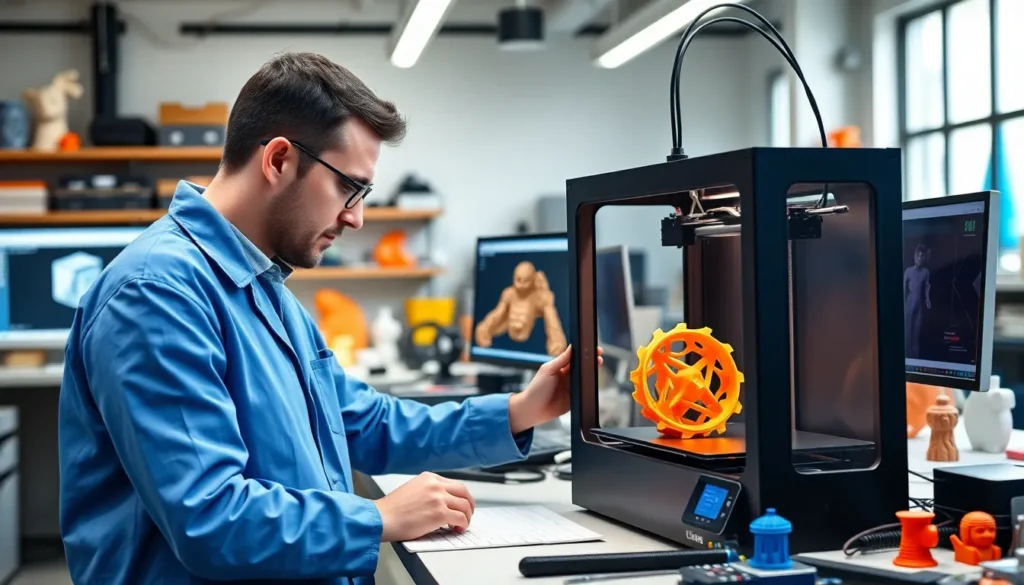Table of Contents
ToggleImagine a world where your wildest ideas leap from your imagination into reality, all thanks to the magic of 3D printing. This revolutionary technology isn’t just for sci-fi movies anymore; it’s transforming industries and even our everyday lives. From intricate jewelry to life-saving medical devices, 3D printing is like having a personal genie—minus the lamp and the three wishes.
Overview of 3D Printing
3D printing, known as additive manufacturing, uses digital models to create physical objects layer by layer. This technique allows for intricate designs that traditional methods can’t efficiently produce. Industries like aerospace and automotive leverage this technology for prototyping and production, enhancing efficiency and reducing waste.
Medical fields benefit significantly from 3D printing. It enables the creation of customized implants, prosthetics, and anatomical models for surgical planning. In 2022, a report indicated that the global 3D printing market reached approximately $15 billion, highlighting its growing significance.
Art and fashion sectors embrace 3D printing for unique jewelry and clothing designs. Artists utilize the technology to bring complex concepts to life, enabling a fusion of creativity and technology. Hence, customization becomes easier, tailoring products to individual preferences.
In education, 3D printing supports hands-on learning by providing materials for student projects. This engagement fosters creativity and innovation among students, preparing them for future technological advancements. Institutions integrating 3D printing into curricula often report increased student interest in STEM fields.
Sustainability emerges as a critical advantage of 3D printing. By utilizing only the necessary materials for production, it minimizes waste compared to traditional manufacturing processes. Brands are exploring biodegradable materials to further reduce environmental impact.
3D printing continuously evolves, with advancements in materials and techniques enhancing its versatility. As research progresses, applications may expand into construction, food production, and beyond. Innovations promise to redefine how people create, design, and manufacture products across various sectors.
Types of 3D Printing Examples

3D printing spans various sectors, showcasing its versatility in creating innovative solutions. Below are notable examples across different industries.
Industrial Applications
Industries utilize 3D printing for prototyping and production. Aerospace companies produce lightweight components, improving fuel efficiency and performance. Automotive manufacturers create functional parts and tools, reducing lead times and costs. Additionally, engineers design custom fixtures and jigs, enhancing manufacturing efficiency. Reports highlight that around 25% of manufacturers integrate 3D printing into their processes. As this technology advances, the potential for more complex geometries increases, broadening industrial applications.
Medical Innovations
Healthcare professionals leverage 3D printing for groundbreaking devices and solutions. Customized prosthetics and implants cater to individual patient anatomy, enhancing comfort and functionality. Surgical planning benefits from 3D-printed anatomical models, allowing surgeons to rehearse complex procedures. Furthermore, the creation of bioprinted tissues and organs shows promise for future medical advancements. With the market for medical 3D printing projected to reach $6 billion by 2025, its impact on patient care and treatment options continues to grow.
Consumer Products
Consumers enjoy the perks of 3D printing in a variety of unique items. The fashion industry embraces this technology for innovative clothing and accessory designs, enabling customization. Jewelry designers craft intricate pieces, captivating those seeking personalized items. Home decor products also benefit from 3D printing, with unique designs that reflect individual taste. As consumer interest rises, companies explore new ways to integrate 3D printing, making personalization and creativity more accessible than ever.
Benefits of 3D Printing
3D printing offers numerous advantages across various industries. Enhanced customization capabilities allow businesses to create tailored products, meeting specific customer needs. It reduces production costs by minimizing material waste, as the process utilizes only the required amount of resources.
Speed plays a crucial role; objects can be produced in hours instead of days. Many manufacturers report significantly shorter lead times, improving overall workflow efficiency. Prototyping becomes more accessible, enabling rapid iterations based on feedback.
In the medical sector, customized implants and prosthetics transform patient care. Anatomical models support surgical planning, improving outcomes. Bioprinting techniques hold the potential to revolutionize organ transplants, addressing critical shortages.
Sustainability stands out as a key benefit. By utilizing biodegradable materials, companies contribute to lowering environmental impact. The technology also fosters innovation in educational settings, where students can engage in hands-on learning experiences that stimulate interest in STEM fields.
The art and fashion industries leverage 3D printing to produce unique designs. Artists and designers experience newfound freedom to explore complex shapes and structures, enhancing creative expression. Furthermore, 3D printing contributes to the production of unique home decor items, allowing consumers to personalize their spaces.
As advancements in materials and methods continue, the potential applications of 3D printing will expand. Businesses and individuals alike will benefit from this transformative technology, reshaping how products are designed and manufactured. The increasing integration of 3D printing into everyday life highlights its role as a catalyst for innovation across sectors.
Challenges and Limitations
3D printing faces several challenges that limit its widespread adoption. High initial investment costs present a barrier for smaller businesses entering the market. Companies must acquire advanced equipment and materials, which can deter potential users.
Material limitations create hurdles in producing high-quality objects. While various materials exist, not all are suitable for every application. Specific industries, such as aerospace, demand materials that enhance performance, which may not yet be compatible with 3D printing processes.
Speed of production also poses a challenge. Although 3D printing enables rapid prototyping, larger-scale production can slow down due to lengthy layer-by-layer printing times. Some manufacturers prefer traditional methods for mass production, prioritizing speed over customization.
Quality control issues arise throughout the printing process. Variability in results can occur depending on machine calibration, material consistency, and environmental factors. Companies that require strict tolerances may find these inconsistencies problematic.
Regulatory concerns hinder the adoption of 3D printing in certain industries. In healthcare, for instance, compliance with regulations for medical devices adds extra steps to the manufacturing process. Navigating these complex guidelines can slow down innovation and deployment.
Intellectual property challenges also emerge with 3D printing technology. Protecting designs from unauthorized reproduction becomes increasingly difficult. As designs circulate in digital formats, safeguarding proprietary information requires new considerations.
Despite these challenges and limitations, 3D printing continues to evolve. As technology advances, strategies to overcome these obstacles will likely emerge, enhancing the technology’s role across various sectors.
3D printing is reshaping industries and everyday life with its innovative capabilities. From customized medical devices to unique art pieces it’s clear that this technology is more than just a trend. As businesses and creators continue to explore its potential the benefits of enhanced customization and reduced waste will only grow.
While challenges like high costs and material limitations remain the future looks promising. With ongoing advancements in technology the possibilities for 3D printing are vast and its impact on various sectors will likely deepen. As this transformative force evolves it’s set to redefine how products are designed and produced.





